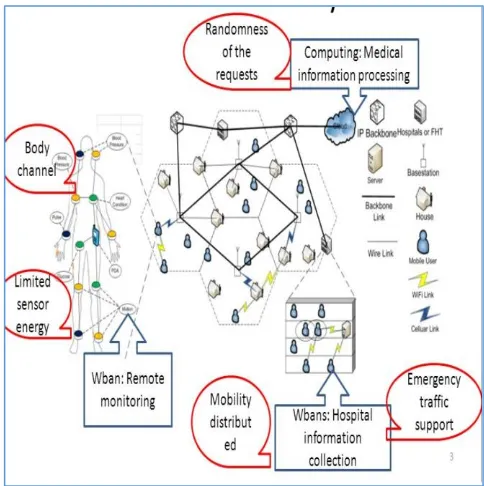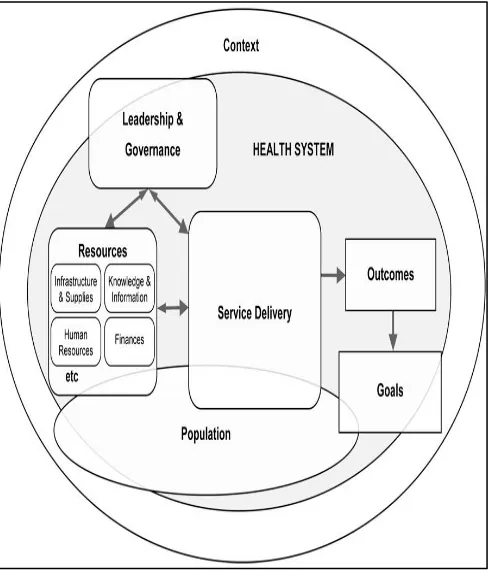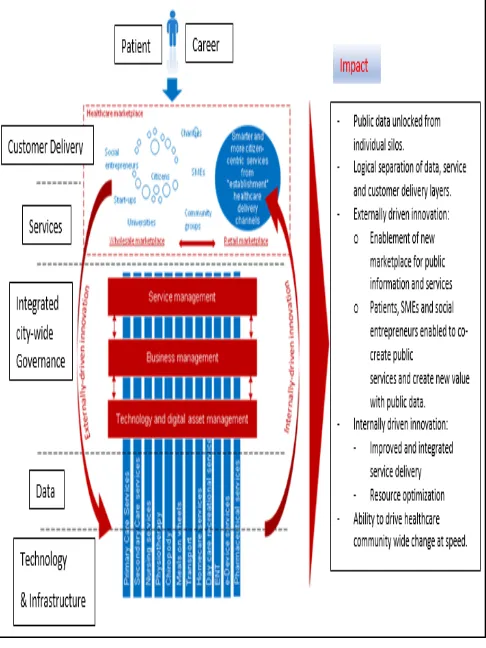© 2016, IRJET | Impact Factor value: 4.45 | ISO 9001:2008 Certified Journal | Page 1303
An Explicit Transformation of Health Care System Using Information
and Communication Technologies (ICTs)
Jasvinder Sidhu
1, Dr. Sanjay Tejasvee
21
Research Scholar, Department of Engineering & Technology ,Tantia University ,Sri Ganganagar, Rajasthan, India.
2
Assistant Professor, Deparment of Computer Applications, Govt. Engineering College, Bikaner, Rajasthan, India.
---***---
Abstract - The main objective of this research paper is to explicate the health care system with the express several interpretations on transformations from conservative health care services practice to electronic health (eHealth) care system. In the current scenario of entire world, it’s incredible to improve any kind of civic centric service without using enhanced and customised Information and communication Technology (ICT) resources. Still, a proper excessive guideline and a roadmap is required for developing an efficient eHealth care system in India. The paper is exactly aimed to provide a framework of general references, organized collection and methods of investigation with respect to digitalization of healthcare phenomena with transformation chattels towards electronic health system. Layer wise integration of several components towards transformation will show at the first vision on this comprehensive research paper. At the end of this paper, a questionnaire will provide for further research work.
Key words: Interpretations, Transformations, eHealth, ICT, Framework, Digitalization, Integration.
1. INTRODUCTION
A Health system is a highly context-specific there is no single set of superlative practices that can be put forward as a model for better performance rather the health systems that function well, have certain collective characteristics. They have procurement and distribution systems that serve involvements to those in need. They have sufficient right skills and motivation to care health and they operate with financing systems that are bearable, inclusive and reasonable. As per world health organization “A health system consists of all organizations, people and actions whose primary intent is to promote, restore or maintain health. This includes efforts to influence determinants of health as well as more direct health-improving activities. A health system is therefore more than the pyramid of publicly owned facilities that deliver personal health services. It includes, for example, a mother caring for a sick child at home; private providers; behaviour change programmes;
vector-control campaigns; health insurance
organizations; occupational health and safety legislation.
It includes inter-sectoral action by health staff, for example, encouraging the ministry of education to promote female education a well-known determinant of better health”.
[image:1.595.314.556.498.741.2]As the widespread and rapid development of information technologies, especially wireless communications with advanced features provided by the Internet have accepted to move ahead the current era into technical era. It led the Information society development too. Information society is treated as educated and practicable knowledge collected generation [1], which use Information and Communication Technology (ICT) for gathering information (Webster, 2006). Health systems must also be defined in terms of their functions, including the direct provision of services, whether they are public health care related services, but also "other enabling functions, such as stewardship, financing, and resource generation, including what is probably the most complex of all challenges, the health workforce.”[4].
© 2016, IRJET | Impact Factor value: 4.45 | ISO 9001:2008 Certified Journal | Page 1304
These days, scientific researches should be madeconcentrating more on the computer literate citizens but at the same time not forgetting illiterate part of society too,because subsequent development of digital or electronic services would help to resolve computer illiteracy problems in the country and thereby would modernize public sector including public health care system and make it more efficient. One of the substantial challenges the health care community will face on their journey, is the need to establish national standards that will ensure systems integration and interoperability. “The restructuring has focused on finding effective ways to satisfy the needs and desires of the patients. Consumer satisfaction is a basic requirement for healthcare provider because, the satisfaction related to quality of healthcare is provided by hospitals. Satisfaction is important when patients themselves and institutional healthcare service buyers make selection decision” [5].
E-health is a relatively recent term for healthcare practice supported by electronic processes and
communication, dating back about 1999. Some argue
that it is interchangeable with health informatics with a broad definition covering electronic/digital processes in health[6] while others use it in the narrower sense of healthcare practice using the Internet. [7][8][9].
A systematic process of providing health-care services regard of their skill engage in certain related activities to achieve their objectives and the resources are brought together and related in harmony with honesty so that end result may be accomplished by all within the determined constraints of cost, time and effort.
2. FRAMEWORK AND UP-FRONT ASPECTS
OF A HEALTH SYSTEM
We should become acquainted with a theoretical framework for understanding their use, development and effect before beginning the erudition about information and service delivery systems. A health care system is a collection of people, medical resources and methods to accomplish a specific medical task. A systematic medical service delivery system is an integration of components, or entities that interact to achieve a citizen centric health problem.
In a health care system, the system’s environment also plays a vital role which consists of people organizations and other systems that supply data to or that receive data from the system. It is not surprising that different managers perceive the environment differently. All subsystems are self-contained unit and a part of the large design and functioning system.
[image:2.595.318.563.142.427.2]In the health systems framework, social exclusion overlaps with the interface between population, health system, and context. [11]
Fig -2:Health Care System Framework
As per healthcare system context discussion, we can draw the following outlines regarding health care system aspects:
i. Health Information: A well-functioning health information system is one that confirms the invention, analysis, propagation and use of consistent and timely information on health factors and health status.
ii. Health Workforce: A well-performing health workforce is one that works in ways that are responsive, fair and efficient to achieve the best health outcomes possible, given available resources and circumstances.
iii. Health Facility: A Good health service is that which deliver in efficient and effective manner with safe and non-personal health interferences to those who need them most, when and where needed, with minimum waste of resources. iv. Medicines and Technologies: A
© 2016, IRJET | Impact Factor value: 4.45 | ISO 9001:2008 Certified Journal | Page 1305
v. Health Funding and Cost: A good healthfinancing system raises adequate funds for health, in ways that ensure people can use needed services, and are protected from financial catastrophe or impoverishment associated with having to pay for them. It provides incentives for providers and users to be efficient.
vi. Leadership, Direction and Governance: Involves ensuring strategic policy frameworks exist and are combined with effective oversight, coalition building, regulation, attention to system-design and accountability.
3. TRANSFORMATION CHATTELS TOWARDS
E-HEALTH CARE
The purpose is to develop mechanisms for integrated service delivery where conceivable. A proper health care mechanism also encourage continuance of care for an individual when needed and provide varied levels of care over a lifetime.
At present, the foremost constraint is fiscal feasibility of e-healthcare initiatives. However there have been several isolated initiatives from various organizations and hospitals for implementation of project. Investigations can be viewed by a group of experts. A decent model will reduce the initial project costs and with the patient traffic from several associated hospitals can achieve economy of scale.
The reduced costs of trained manpower and quantifiable costs will provide a very efficient optimal service to the civic. The transformation is to enable the technology of government to deliver customer-centric health care services. The ideologies set out in that pattern apply equally to the guidance of the e-Health programme and the delivery of care and services to patient. The transition to e-Health has involved overlaying technology onto the existing functioning model of the health care segment.
The existing functional or operating model based on functionally-oriented departments, agencies and practitioners, behave like unconnected silos in which policy-making, budgets, accountability, decision-making and service delivery are all surrounded within a vertically-integrated delivery chain. These focus more on delivery functions rather than patient needs.
3.1 Traditional Functioning Model of Health
Care:
Without examination of or essential change to, the underlying corporate model level, the design and
[image:3.595.317.562.181.489.2]delivery of care and services remains fragmented and driven by the structures of the civic, rather than the needs of the patients. Following Figure 3 demonstrates the traditional functioning health care model which is still typical of most governments and healthcare communities:
Fig. 3 – Traditional functioning model [14]
In the traditional functioning, the individual patient usually has to encompass separately with each silo and making connections for themselves rather than receiving whole and connected service that meets their needs. Data and information has typically been protected within these silos, restrictive the possible for association and modernization across the public.
Before we will forward towards transformation from traditional health care system to electronic health care system, we should have to focus on some important points such as:
i. Adaptation of Information technology by hospitals especially in terms of networking and Hospital Management systems.
ii. Increasing awareness on IT among medical professionals.
iii. Provide better Internet access, and perhaps the advent of broadband in India that can transfer video files faster.
© 2016, IRJET | Impact Factor value: 4.45 | ISO 9001:2008 Certified Journal | Page 1306
equipment manufacturers. Decline in the cost oftelemedicine hardware to make it more financially feasible.
3.2
E-Health Care Functioning Model:
[image:4.595.38.281.336.660.2]Transformation from a traditional healthcare system to e-heathcare system can acquire and disseminate state-of the art and trusted knowledge in the field of governance through documentation of good and innovative practices with open access to reputable sources from governance experts including working papers, government reports, policy briefings etc. and provide updated access to pertinent governance related news and latest announcements. A helpdesk allowing users to receive solutions to governance queries from a panel of experts. Integrated transformation can provide to facilitate stakeholder engagement to create collaborative knowledge on issues of public service delivery through systemic, expert solution exchange between experts and registered users.
Fig 4 – Transformed and Integrated health care functioning model (eHealth Care Model)
Healthcare transformation system is an integrated phenomenon containing alterations in emphasis, away from silo based deliverance and multi-way service delivery approach to an approach that enables a whole of community view of the patient and an
ability to deliver services to patients where and when they need it ,including through one stop services solution. It ensures that data on the performance and use of the healthcare community’s physical, spatial and digital assets is available in real time and on an open and interoperable basis. It enables real-time integration and optimization of resources. Transformed E-health care system also manages public sector data as an asset
and enables externally driven, stakeholder led
innovation by patients, carers, communities by opening up data and services for the common good. It also provide patients with healthcare and services, which are accessible in one stop with setting holistic and flexible
budgets, with a focus on value for money beyond standards.
There are several advantages of e-health care transformation such as:
• Integrated service delivery packages will continue to produce and disseminate cost-effectiveness data for prevention and treatment, and define service standards and measurement strategies for tracking trends and inequities in service availability, coverage and quality.
• Service delivery models will increase efforts to capture experience with models for delivering personal and non-personal services in different settings, including fragile states. It will consider the whole network of public and private providers in order to enhance equitable access, quality and safety. It will consider the stewardship and governance implications of different service delivery models, for example, legislation for non-communicable diseases, approaches to regulating private providers and the consequences for health services of decentralization to local government.
• Leadership and management will support Member States to improve management of health services, resources and partners by health authorities, as a means to expand coverage and quality.
• Digital formatting enables information to be used and shared over secure networks.
• Track care (e.g. prescriptions) and outcomes (e.g. blood pressure)
• Trigger warnings and reminders
• Send and receive orders, reports, and results
• Decrease billing processing time and create more accurate billing system.
• Real-time and daily monitoring possible to boosting patient satisfaction.
© 2016, IRJET | Impact Factor value: 4.45 | ISO 9001:2008 Certified Journal | Page 1307
4. FUTURE RESEARCH SCOPE AREA TO
INVESTIGATE
Following tasks are still pending to investigate each of them have its own significance, these are:
1. What role players participate and influence development of e-Health?
2. What useful suggestions could be given for countries developing e-Health system?
3. How does electronic healthcare services package differ in different countries?
4. What Implication has Supply Chain Management developing e-Health?
5. How does the formation and progress of value chain impacts development of Health care system? 6. How Customer Relationship Management helps to
develop E-health care system?
All the above mentioned tasks will give guidelines to the researchers as to how to represent developing e-Health system. Collected and processed data in empirical research will show, if it is useful for another country to petition and to experience of countries advanced in developing their e-Health system at all. Comprehensive research may not be adequate to the reality and it will require for more researches. These things we will be known in the further research work.
5. CONCLUSION
Dealing with global information and service delivery to large number of people connected by national infrastructures requires the need to split the global governance of the physical infrastructures and the private and public controlled services running on them. Exact mean of ehealth care system is the transformed and integrated functional technical approach to enhance health care process. The Government of India recently also came up with an initiative to integrate the different sections and departments. The main goal is to ensure the availability of the health care services to people through the electronic medium. The Indian government has exactly started the digital India programme to digitize India by making good use of technology to enable access of services from several sectors to the citizens. Be it Banking, Education, Healthcare, Agriculture or any core sector for that matter is the key focus area under this programme. Electronic transformation of health care system will be done through promoting tools for analysing barriers to care, and remove management weaknesses, generating and sharing knowledge on strategies to improve management, often in the context of decentralization; developing local resource institution’s capacity to support local health managers
and developing methods to monitor progress. Today, Government has the responsibility for framing the basic standards guidelines to make use of IT in healthcare. The ICT Ministry has come out with its recommendations by recommending some basic standards.
REFERENCES
[1] The European Commission (2006): “European Business. Facts and Figures & Data (1995 2005)”.
[2] Webster, f. (2006): “Information theorises”. Kaunas.
[3] Everybody Business: Strengthening health systems to improve health outcomes: who’s framework for action; © world health
organization 2007;
http://www.who.int/healthsystems/strategy/e
verybodys_business.pdf. World health
organization.
[4] Frenk j (2010), "The global health system: strengthening national health systems as the next step for global progress".
[5] http://www.ijsrp.org/research-paper-0812/ijsrp-p0891.pdf.
[6] International telecommunication
union. "implementing e-health in developing countries: guidance and principles".
[7] Himss sig develops proposed e-health
definition", himss news, 13(7): 12.
[8] Eysenbach, g; diepgen (jan–feb 2001). "the role of e-health and consumer health informatics for evidence-based patient choice in the 21st century". Clin dermatol. 19 (1): 11–7.
[9] Ball, mj; lillis, j (apr 2001). "e-health:
transforming the physician/patient
relationship". Int j. med inform. 61 (1): 1–10. [10] Della mea, vincenzo (2001). "what is e-health
(2): the death of telemedicine?". Journal of medical internet research. 3 (2)
[11] Analysing health systems to make them stronger;http://www.strengtheninghealthsyste ms.be/topic7.html.
[12] http://indiagovernance.gov.in.
[13] "Electronic health records: what's in it for everyone?".
[14] http://www.thesolitarywriter.com. [15]
http://docs.oasis-open.org/tgf/tgf-ehealth-profile/v1.0/tgf-ehealth-profile-v1.0.html.
[16] Information technology revolution in
healthcare; http://www.medindia.net/articles. [17] www.scsolutions.com/structural/publications [18] Gerhard Bethscheider Satellite is vital for
unified, global, e-health system; September 2015 World Teleport Association.
© 2016, IRJET | Impact Factor value: 4.45 | ISO 9001:2008 Certified Journal | Page 1308
[20]https://www.itu.int/ITU-D/cyb/app/docs/e-Health_prefinal_15092008.PDF
[21] WHO's Global Observatory for eHealth: http://www.who.int/goe/


![Fig. 3 – Traditional functioning model [14]](https://thumb-us.123doks.com/thumbv2/123dok_us/8181042.810738/3.595.317.562.181.489/fig-traditional-functioning-model.webp)
